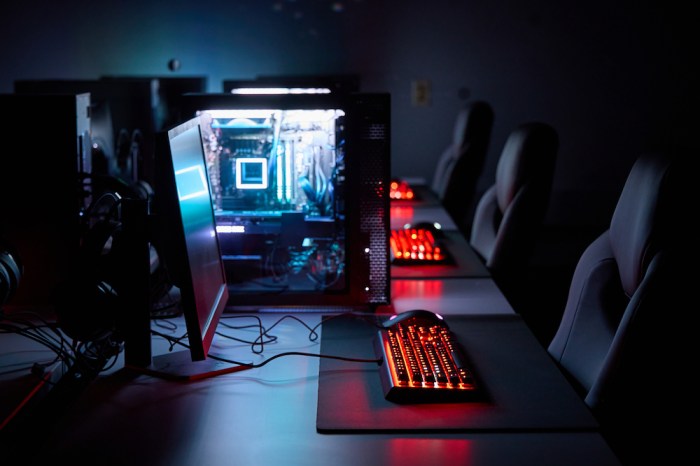Esports hardware isn’t just about flashy lights; it’s the foundation of competitive gaming. From lightning-fast monitors to precision mice, every piece of equipment plays a crucial role in a player’s success. We’re diving deep into the world of high-performance gear, exploring the tech that separates the pros from the weekend warriors, and helping you build a setup that’ll elevate your game.
This guide covers everything from the essential components – monitors, mice, keyboards, and headsets – to the often-overlooked but equally important peripherals like gaming chairs and mousepads. We’ll break down the specs, compare different technologies, and even offer some tips on building your own killer esports PC. Get ready to level up your setup!
Gaming Monitors for Esports
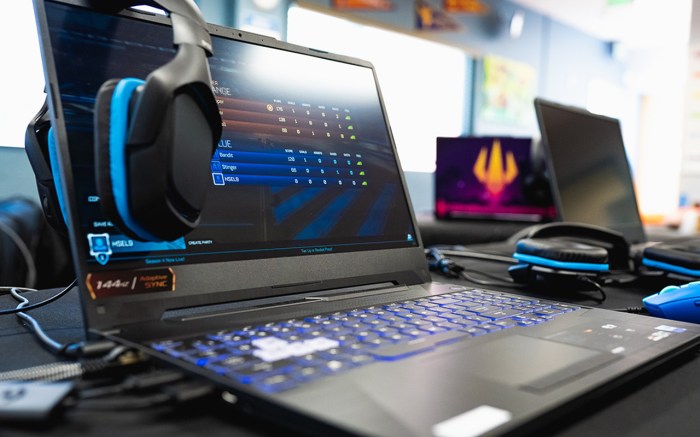
Choosing the right gaming monitor is crucial for competitive esports. A top-tier monitor can significantly improve your reaction time, visual clarity, and overall performance, giving you a competitive edge. The key specifications to consider revolve around refresh rate, response time, resolution, and panel type. Ignoring these factors could mean the difference between victory and defeat.
Ideal Specifications for Esports Gaming Monitors
For esports, you want a monitor that minimizes input lag and provides a smooth, responsive visual experience. This translates to a high refresh rate (ideally 240Hz or higher), a low response time (1ms or less), and a resolution that balances visual detail with performance (1080p or 1440p are common choices). The panel type also plays a significant role in image quality and response time.
Comparison of Monitor Technologies (TN, IPS, VA)
TN (Twisted Nematic), IPS (In-Plane Switching), and VA (Vertical Alignment) panels each offer different strengths and weaknesses relevant to gaming. TN panels boast the fastest response times, crucial for minimizing ghosting and motion blur in fast-paced games. However, they often suffer from limited color accuracy and viewing angles. IPS panels provide superior color accuracy and wider viewing angles, but generally have slower response times than TN panels.
VA panels offer a compromise, providing decent color accuracy and contrast ratios with response times that fall somewhere between TN and IPS. For esports, the speed advantage of TN panels often outweighs the color accuracy benefits of IPS or VA, especially at higher refresh rates.
Comparison of Popular Esports Gaming Monitors
| Monitor | Price (USD) | Resolution | Refresh Rate (Hz) | Response Time (ms) | Panel Type | Features |
|---|---|---|---|---|---|---|
| ASUS ROG Swift PG259QN | $600 – $700 | 1920 x 1080 | 360 | 1 | TN | G-Sync Compatible, High refresh rate |
| BenQ Zowie XL2546K | $400 – $500 | 1920 x 1080 | 240 | 1 | TN | Black eQualizer, Low input lag |
| LG 27GL850 | $400 – $500 | 2560 x 1440 | 144 | 1 | IPS | FreeSync, HDR10 |
| Acer Predator XB273K | $600 – $700 | 3840 x 2160 | 144 | 1 | IPS | G-Sync Compatible, HDR |
Note: Prices are approximate and can vary based on retailer and sales.
Importance of G-Sync/FreeSync for Competitive Gaming
G-Sync (Nvidia) and FreeSync (AMD) are adaptive sync technologies that synchronize your monitor’s refresh rate with your graphics card’s frame rate. This eliminates screen tearing and stuttering, resulting in a smoother and more consistent gaming experience. In competitive gaming, even minor inconsistencies in frame rate can impact performance. G-Sync and FreeSync help to mitigate these issues, providing a more predictable and responsive visual experience, giving players a slight but noticeable advantage.
For example, a sudden frame drop in a fast-paced shooter could mean the difference between landing a shot and missing it entirely. Adaptive sync technologies help minimize these kinds of unpredictable performance hiccups.
Esports Keyboards
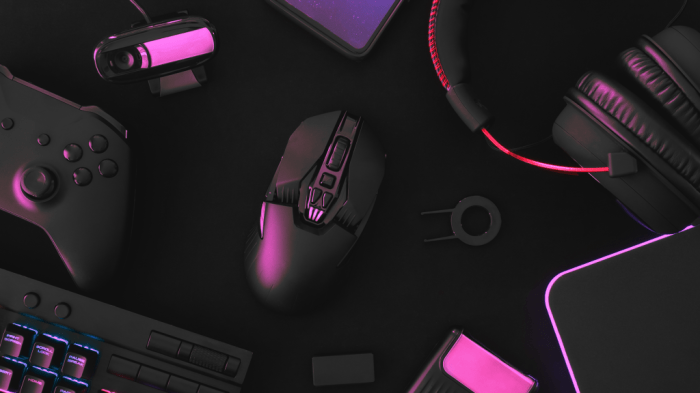
Choosing the right keyboard can be a game-changer in esports. A high-performance keyboard provides the speed, accuracy, and reliability needed to compete at the highest level. The right keyboard can mean the difference between victory and defeat, especially in fast-paced games where milliseconds matter. This section will dive into the key features that make an esports keyboard stand out.
Essential Characteristics of High-Performance Esports Keyboards, Esports hardware
High-performance esports keyboards share several key characteristics. These features work together to provide the responsiveness and durability required for competitive gaming. The combination of these features creates a significant advantage for professional players.
Mechanical vs. Membrane Keyboards in Esports
The choice between mechanical and membrane keyboards is a crucial one for esports players. Mechanical keyboards, known for their tactile feedback and responsiveness, are overwhelmingly preferred in the professional scene. Membrane keyboards, while generally more affordable, lack the precision and responsiveness needed for fast-paced gameplay. The distinct click and tactile feedback of mechanical switches allows for faster reaction times and improved accuracy.
The quicker response time and durability also contribute to a more reliable performance. While membrane keyboards offer a quieter typing experience, this benefit is often outweighed by the performance advantages of mechanical keyboards.
Popular Esports Keyboard Switches and Their Pros and Cons
Selecting the right switch type is a personal preference, but some switches are more popular than others within the esports community. The choice often depends on individual playing style and preferences.
- Cherry MX Red: Linear, smooth keystrokes; very fast actuation; relatively quiet; can be prone to accidental key presses for some users.
- Cherry MX Brown: Tactile feedback with a slight bump; good compromise between speed and accuracy; less prone to accidental key presses than Reds; slightly slower actuation than Reds.
- Cherry MX Blue: Tactile feedback with a pronounced bump and audible click; very responsive; provides excellent feedback; can be quite loud.
- Cherry MX Speed Silver: Linear, extremely fast actuation; designed for speed; can be less forgiving for accidental key presses.
- Kailh Box White: Linear, smooth keystrokes; very fast actuation; durable; very loud.
Comparison of Keyboard Features: Anti-Ghosting and N-Key Rollover
Anti-ghosting and N-key rollover (NKRO) are critical features for preventing input errors during intense gameplay. These features ensure that every key press is registered accurately, even when multiple keys are pressed simultaneously. The absence of these features can lead to frustrating missed inputs during crucial moments.
| Feature | Description | Impact on Esports |
|---|---|---|
| Anti-Ghosting | Prevents multiple key presses from being ignored when pressed simultaneously. Typically handles a limited number of simultaneous key presses. | Reduces input errors, especially in games requiring many simultaneous key presses. |
| N-Key Rollover (NKRO) | Registers every key press regardless of how many keys are pressed at once. | Ensures flawless input even during the most intense moments of gameplay, providing a significant competitive advantage. |
PCs and Laptops for Esports: Esports Hardware
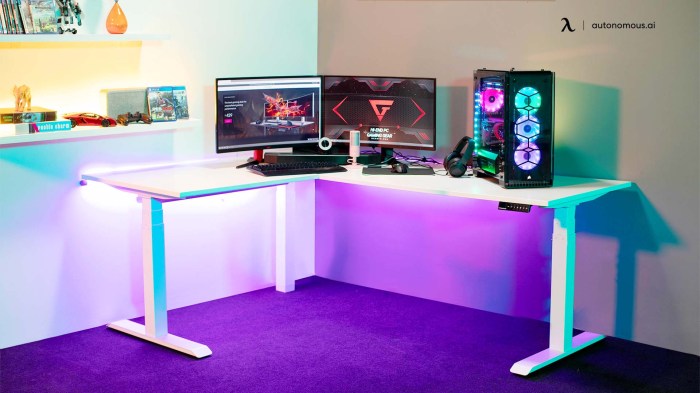
Choosing the right hardware is crucial for success in esports. While peripherals like monitors and keyboards are important, the foundation of any competitive setup is the PC itself – whether desktop or laptop. The performance difference between a top-tier system and a budget one can be the difference between victory and defeat. This section will explore the hardware requirements, the desktop vs.
laptop debate, and the critical role of CPU, GPU, and RAM in achieving peak esports performance.
Minimum Hardware Requirements for Competitive Gaming
Different esports titles have varying hardware demands. A game like
Counter-Strike
Global Offensive* (CS:GO) is less demanding than something likeValorant*, which in turn is less demanding than a visually intense title like
Call of Duty
Modern Warfare II*. However, we can establish some general minimum specifications for competitive play across a range of popular titles. A system that comfortably runs these minimum requirements will provide a playable experience, though higher specs will naturally lead to better performance and a smoother gameplay experience.
| Component | Minimum Specification (Competitive Play) | Recommended Specification (High-Refresh Rate) |
|---|---|---|
| CPU | Intel Core i5-8400 or AMD Ryzen 5 2600 | Intel Core i7-12700K or AMD Ryzen 7 5800X3D |
| GPU | Nvidia GeForce GTX 1660 or AMD Radeon RX 580 | Nvidia GeForce RTX 3070 or AMD Radeon RX 6700 XT |
| RAM | 16GB DDR4 | 32GB DDR5 |
| Storage | 512GB SSD | 1TB NVMe SSD |
Desktop PC vs. Gaming Laptop for Esports
The choice between a desktop PC and a gaming laptop often comes down to portability versus performance and upgradeability.
| Feature | Desktop PC | Gaming Laptop |
|---|---|---|
| Portability | Low | High |
| Performance | Generally Higher | Generally Lower (for the same price) |
| Upgradability | High | Low |
| Price | Can be more affordable for high-end specs | Typically more expensive for comparable performance |
| Cooling | Easier to manage | More challenging, often leading to thermal throttling |
Importance of CPU, GPU, and RAM in Esports Performance
The CPU, GPU, and RAM are the core components driving esports performance. Each plays a distinct role:* CPU (Central Processing Unit): The CPU handles game logic, AI, and physics calculations. A powerful CPU ensures smooth gameplay, especially in fast-paced games with many in-game elements. A weak CPU can lead to stuttering and lower frame rates.* GPU (Graphics Processing Unit): The GPU renders the game’s visuals.
A strong GPU is crucial for high frame rates and smooth visuals, especially at higher resolutions and settings. A weak GPU will result in lower frame rates and potentially reduced visual fidelity.* RAM (Random Access Memory): RAM acts as short-term memory for the system. Sufficient RAM allows the game and operating system to run smoothly without stuttering or lag.
Insufficient RAM can lead to performance bottlenecks, particularly in games with large maps or many assets.
Sample High-Performance Esports PC Build
This parts list focuses on building a high-performance PC capable of handling the demands of modern esports titles at high refresh rates.
| Component | Part Choice | Notes |
|---|---|---|
| CPU | AMD Ryzen 7 7700X | Excellent balance of price and performance |
| CPU Cooler | Noctua NH-D15 | High-performance air cooler for efficient cooling |
| Motherboard | MSI B650 Tomahawk WIFI | Reliable and feature-rich motherboard |
| RAM | 32GB (2x16GB) DDR5-6000 | Fast RAM for smoother gameplay |
| Component | Part Choice | Notes |
|---|---|---|
| GPU | Nvidia GeForce RTX 4070 | High-performance GPU for high refresh rate gaming |
| Storage | 1TB NVMe PCIe 4.0 SSD | Fast storage for quick load times |
| Power Supply | 850W 80+ Gold Certified PSU | Sufficient power for all components |
| Case | Fractal Design Meshify 2 Compact | Excellent airflow for cooling |
Other Peripherals
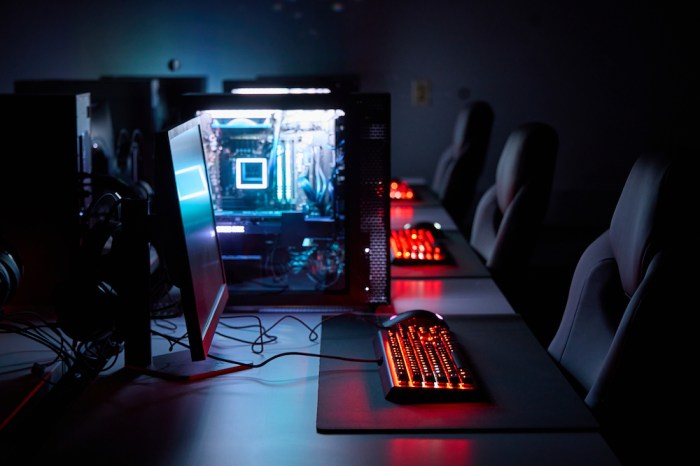
Beyond the core components of a gaming setup, several other peripherals significantly impact the esports experience. These often-overlooked items can dramatically improve comfort, precision, and overall performance, leading to a more enjoyable and successful gaming session. Let’s delve into some key examples.
Gaming Chairs and Posture
Maintaining proper posture during extended gaming sessions is crucial for preventing discomfort and potential long-term health issues. A high-quality gaming chair, designed with ergonomic features, provides essential support for the back, neck, and lumbar region. Features like adjustable lumbar support, height adjustment, and armrests allow for personalized comfort, minimizing strain and promoting better posture. This leads to reduced fatigue and improved focus, allowing for peak performance during competitions.
For example, chairs with breathable fabrics can help regulate body temperature during intense gameplay, preventing overheating and discomfort.
High-Quality Mousepads and Precision
The mousepad might seem like a minor detail, but its impact on gameplay is undeniable. A high-quality mousepad provides a consistent, smooth surface for precise mouse movements. This is particularly crucial in esports, where even slight inaccuracies can cost valuable seconds. Different mousepads offer varying surface textures and materials, catering to different mouse sensor types and player preferences.
For instance, cloth mousepads provide excellent control and glide, while hard plastic mousepads offer superior speed. Choosing the right mousepad is a personalized decision, but the benefits of a superior surface for accuracy and consistency are clear.
Enhancing the Esports Experience with Additional Peripherals
Beyond chairs and mousepads, other peripherals can significantly enhance the esports gaming experience. Streaming equipment, such as high-quality microphones and webcams, allows for engaging content creation and community interaction. This is especially important for aspiring professional gamers who aim to build a personal brand and connect with their audience. Similarly, effective cooling solutions, such as high-performance CPU coolers and case fans, are vital for maintaining optimal PC temperatures, preventing thermal throttling, and ensuring consistent performance during intense gameplay.
These additions, while not directly involved in gameplay, contribute to a more professional and efficient gaming setup.
Gaming Mouse Bungees and Cable Management
A high-end gaming mouse bungee addresses a common frustration: cable drag. This simple device elevates the mouse cable, preventing it from snagging or interfering with precise movements. Features like adjustable height and sturdy construction ensure smooth cable management and eliminate the distracting friction that can occur with a standard cable setup. A well-designed bungee contributes to improved accuracy and responsiveness, leading to better in-game performance.
The bungee acts as a cable management solution, keeping the cable out of the way and enhancing the overall gaming experience.
Q&A
What’s the difference between TN, IPS, and VA panels?
TN panels offer the fastest response times, ideal for competitive gaming, but often have less vibrant colors. IPS panels boast superior color accuracy and viewing angles, but response times are slower. VA panels fall somewhere in between, offering a balance of response time and color quality.
How important is a high DPI mouse?
High DPI (dots per inch) allows for more precise cursor movement. While a very high DPI isn’t always necessary, having the option to adjust it to your preference and sensitivity is beneficial. It’s more about finding the right DPI for
-your* playstyle.
What’s the deal with mechanical vs. membrane keyboards?
Mechanical keyboards are generally preferred in esports due to their faster response times, durability, and tactile feedback. Membrane keyboards are cheaper but often lack the responsiveness needed for competitive play.
Do I really need a gaming chair?
While not strictly necessary, a good gaming chair can significantly improve comfort during long gaming sessions, leading to better focus and performance. It’s an investment in your overall well-being, especially if you play for extended periods.
